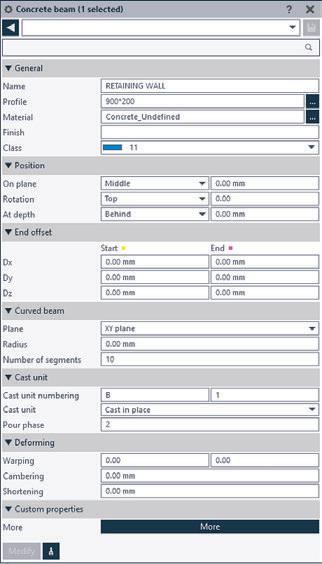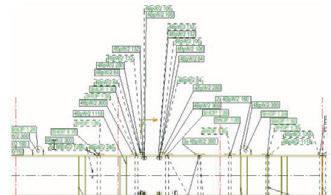
13 minute read
2018 review
Tekla Structures 2018
Trimble brings its structural BIM tool up to date with new workflows for complex modelling and design automation as well as support for point clouds.
by Greg Corke
Tekla Structures has changed beyond all recognition from the days of XSteel, the steel detailing software from which it evolved. The structural BIM tool may still have a core customer base of steel fabricators, but it has expanded its reach significantly over the years and now covers design all the way to construction, for steel, reinforced concrete and pre-fabricated concrete projects.
There’s one core product, but different licences give access to the many different task-specific features. There’s even a licence catering to firms working on smaller projects, that limits the number of steel parts or reinforcement bars in a model.
For the 2018 release, Trimble looks to have taken inspiration from architectural BIM tools, adding support for point clouds, a live link to the algorithmic modelling tool Grasshopper, as well as better quality graphics, and improved usability through an enhanced user interface. The new release is also faster than Tekla Structures 2017i, which Trimble admits was slower in some areas than the release before.
But Trimble has not forgotten its bread and butter that is steel fabrication. There are a number of new enhancements to make drawing production more efficient.
We’ll look at all of these new features and more in this review.
Grasshopper-Tekla Live Link One of the most exciting new developments is the new Grasshopper-Tekla Live Link. Grasshopper extends the popular NURBS modelling tool Rhino with algorithmic modelling functionality.
The software is very powerful, very popular and very affordable and is used by architects around the world for anything from generative design to robotic control. But it’s also very graphical, so generally much easier to work with, compared to other algorithmic modelling tools.
Through the new live link, Grasshopper can drive geometry creation inside Tekla Structures. From a structural engineer’s perspective, it could be used to realise an architect’s vision for a hitech building, rather than having to model everything from scratch in Tekla Structures. But it can also be used to quickly generate a structure that’s either exceptionally intricate, such as a double curved roof or complex concrete shell, or repetitive based on a parametrically driven template.
Here, an example, could be something as simple as a portal frame with a mezzanine floor. The fabricator would simply create a Grasshopper script for a certain type of structure then punch in the number of bays, height of the eaves and height of the apex and the design is automatically generated inside Tekla Structures. Importantly, if you then change any of the parameters in Grasshopper, the design instantly updates in Tekla Structures.
Tekla Structures does have its own API for performing tasks like this, but Grasshopper has the benefit of being very visual and, importantly, used everywhere. There’s a big pool of architects and engineers graduating from university with the necessary skills.
The Grasshopper-Tekla Live Link is not part of Tekla Structures 2018 per se – it’s an extension available in the Tekla Warehouse – but it only works with this latest 2018 release. By offering extensions like this, Trimble is able to develop new tools and make them available to customers much quicker. They can then be refined, following user feedback, and often brought into the next full release of the software.
User Interface Tekla introduced a new ribbon user interface in 2016 and has been refining it ever since. One of the biggest changes in 2018 is the new property pane, which makes it much easier and quicker to handle and modify object properties in Tekla Structures.
With previous versions, selecting multiple objects brought up several cascading dialogue boxes, each containing the individual properties of specific objects. Now everything is handled in the property pane which allows you to quickly see which properties are common, which properties are not, and then modify them accordingly, all in one go.
There’s also a new online side pane that helps new users search and access online
3 4
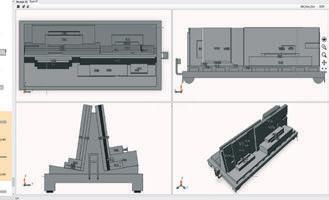

help, learning materials, and forum posts. It can also use notifications to alert users to new features and service pack releases.
Another UI change is the base points and work plane handler, which makes it much easier to control which work plane is currently active in the model. It could be used for carrying out specific modelling tasks, or to align your model to the co-ordinate system of imported data.
The final two UI changes we’ll cover are very simple, but effective. The Undo history command allows you to undo or redo several commands in one go. This is great for getting good visibility when correcting mistakes, as the model history clearly lists which specific commands will be undone. You can also place bookmarks as you go to make it easy to undo big chunks of work in one click.
The select previous tool allows you to re-select objects that you have accidentally deselected, which can be a real pain if you’ve spent ages selecting multiple objects only to lose your selection accidentally. Of course, for larger selections, users would probably use filtering.
Visual fidelity Tekla Structures now has a brand-new graphics engine based on DirectX that is primarily designed to improve the visual fidelity of the model in the viewport. It does this through the use of subtle shading and ambient occlusion (an effect that renders shadows more realistically) to give more depth to models.
Anti-aliasing reduces the stepped effect on diagonal lines and flicker as the model rotates on screen. The new engine also highlights geometry much better when transparent and renders reinforcing bars with edge lines so they stand out.
Users will need a DirectX 11 compatible graphics card (Tekla recommends Nvidia GeForce) but can still fall back on the old OpenGL engine if they have an older GPU.
Point clouds Tekla Structures has now joined the likes of Revit, MicroStation, ArchiCAD and other AEC software tools by supporting point clouds natively. Users can import a variety of different formats including ASCII, E57, LAS, LAZ, PTS, PTX, Potree and Trimble scan format (.tzf). Import can be quite processor intensive but runs on a separate thread to the core Tekla Structures application, so it shouldn’t slow your workstation down.
The functionality is pretty simple, and it is really just a viewing tool; there are no dedicated point cloud processing tools for registration, raster clean up or automatic object recognition. But there are valuable use cases.
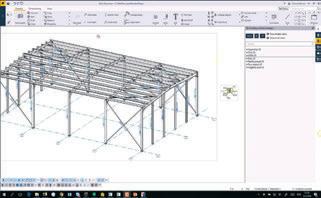
6
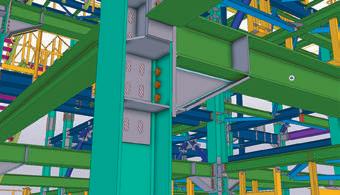
1 The Grasshopper-Tekla Live Link brings algorithmic modelling to Tekla Structures 2 A new mark placing algorithm automatically arranges marks and associative notes more clearly 3 The new ‘Stacker’ tool helps plan how pre-cast units are loaded on the back of a truck and taken to site 4 Tekla Structures now generates better analysis models 5 The new Drawing Content Manager helps users check and edit marks, notes and model objects in drawings 6 The new DirectX graphics engine is designed to improve the visual fidelity of the model in the viewport
The main one is to provide as-built con- and Trimble Connect and vice versa. the plate depth, you’d have to explode it, text for new 3D models. Users can snap to This optimised workflow is a far cry edit the geometry and then recombine points on the point cloud and then model from the file-based workflow champi- everything. Now you can just drag hanTekla Structures objects around it. This oned by Tekla Structures and Tekla dles to make changes. could be a useful tool for an engineer or BIMsight where any issues found inside There’s also a new tool for modelling spifabricator who wants to add a new struc- Tekla BIMsight had to be manually locat- ral beams and more accurate welds, includture to an existing building, such as a mez- ed inside Tekla Structures. Now, the ing compound welds and polygon welds. zanine floor. Previously it would have whole design review process can be very Tools for concrete contractors to help required a traditional survey or the use of seamless and very efficient. streamline the detailed modelling of conthird party software to turn the point cloud The Trimble Connect integration isn’t struable formwork were added to the into a vector model. Now the point cloud just limited to 3D models; you can also Tekla Warehouse a couple of years ago. can be imported directly and used in much collaborate on drawings in a similar way. These originally focused on walls, and spethe same way one would a scanned raster In addition, documents such as PDFs or cific tools for clamps, braces, ties and waildrawing in a 2D CAD system. CNC files can be attached to any object ers have all been updated in 2018.
The second use case is for tracking con- within a model. However, the big new addition is a specific struction progress, by comparing the as- formwork placing tool for slabs which built point cloud to the fabrication model. Analysis links handles panels, girders, and shuttering This is a visual checking process only, not There have been several improvements to props etc. an automated workflow like the one how Tekla Structures works alongside offered in Verity, the dedicated point cloud design and analysis software. Much of Drawing content manager verification tool recently acquired by these centre on improving the way the Despite there being such a big focus on Topcon. However, by structuring the veri- software generates the analysis model, 3D models, Trimble hasn’t forgotten its fication workflow missing objects should reducing the need for manual editing. ‘bread and butter’ deliverable – the 2D be able to be identified quite easily. In previous versions, users may have drawing. Tekla Structures now has a
Tekla also offers ‘Point Cloud found that the analytical nodes of beams, Drawing Content Manager which is Manager’, which can be downloaded columns or braces weren’t connected specially designed to help users check from the Tekla Warehouse. This stan- once imported into their analysis soft- and edit marks, notes and model dalone application uses clip planes to ware. This would result in time-consum- objects in drawings. trim models to size, which can then be exported. It could be use‘‘ The Grasshopper-Tekla Live Link could be Like the property pane, the Drawing Content Manager sits on the ful when a survey company hands you a giant point cloud of an entire used to quickly generate a structure that’s either exceptionally intricate, or repetitive based on a right-hand side of the UI. To check drawings, simply click on individual site, terrain, trees and all, parametrically driven template parts as listed in the but you are only interested in a very specific part of the model. It saves you importing mas- ing manual editing to create a fully con ’’ Drawing Content Manager, then instantly see them or their part marks highlighted sive, multi Gigabyte point clouds into nected analytical model. Now Tekla in the drawing. Tekla Structures which could slow down Structures automatically connects all the Parts can be easily sorted in the list by the system unnecessarily. analytical wires to common nodes, part type, mark quantity, position, class resulting in full connectivity when or profile or you can search for someTrimble Connect exporting to the Tekla Structural thing specific. Welds, bolts and reinforceTo enhance team collaboration, the new Designer analysis software. ment can also be viewed in a similar way release is more tightly integrated with Building on this, Trimble has improved according to their own attributes. Trimble’s multi-disciplinary collabora- the round-trip workflow between the two If part marks are missing, or not tion environment, Trimble Connect. The applications to help keep everything in needed in the drawing, they can be cloud-based tool evolved from Gehry sync. Previously, the physical and analyti- added, removed or edited at the click of Technologies GTeam which Trimble cal models were exported from Tekla a button, as can associative notes. You acquired several years ago. Structures and interpreted by Tekla can also work the other way around –
Tekla Structures models can be linked Structural Designer, but often small mod- select parts in the drawing and see to a Trimble Connect project in the cloud elling errors crept in. Now the analytical them listed in the Drawing Content using the Trimble Connector. Users can model is repaired and improved before it Manager. It’s a simple feature but it’s a check for clashes against project models is exported with the physical model to lot more efficient than manual checking from other disciplines and applications Tekla Structural Designer. with printed drawings. like Autodesk Revit. This can be done Once inside Tekla Structural To bring more clarity to drawings, from within Trimble Connect or from Designer, design changes can be quickly automatically, Tekla Structures now has within Tekla Structures. effected, and the updated model can a new mark placing algorithm that
Any comments that are added to the then be exported and synced back into arranges marks and associative notes project in Trimble Connect can automati- Tekla Structures. more clearly, avoiding crossing leader cally appear inside the model inside Tekla lines. Marks can also be dragged and Structures. It’s a great way of getting live Modelling dropped, highlighted and then automatifeedback from site inspections, for exam- It is now easier to work with bent plates. cally aligned at the click of a button. ple, using an iPad. ToDo notes can also be Previously if you wanted to edit a bent All of these drawing features are probsynchronised between Tekla Structures plate, say to change the angle or adjust ably more useful to engineers, or those
who do lots of bespoke projects, rather than a fabricator who does portal frames day in day out and already has finely tuned templates.
Precast detailing and fabrication Over the past few years Tekla Structures has been expanding into pre-cast concrete. The new release includes a range of tools designed to automate repetitive detailing tasks. This includes an interactive tool for double walls that can insert reinforcement (mesh and additional reinforcement), braced girders, lifters and propping inserts all in one go. It’s parametrically driven so can automatically adjust to the dimensions of the wall.
Bricks can now be added automatically as well. Previously courses had to be placed manually, on a single panel, then copied across.
Pre-cast capabilities now go beyond detailing and a new 3D-model based truck-load planning application called Stacker can help plan how pre-cast units are loaded and stacked on the back of a truck and taken to site.
Conclusion This is an important new release from Trimble which helps bring Tekla Structures up to speed with its architecturally-focused peers.
The point cloud functionality in particular offers new opportunities for engineers and fabricators working on renovation projects. And with low cost, simple to use laser scanners, like the Leica BLK360, as reviewed on page 16, point cloud data acquisition could even be brought in house.
There has also been significant work done on interoperability. The Grasshopper link gives users access to powerful algorithmic modelling tools for quickly generating complex forms. And there are huge opportunities for design automation and a pool of skilled graduates to help firms take advantage.
Analysis also gets some welcome attention by helping keep physical and analysis model properly connected. And the powerful link to Trimble Connect has the potential to transform collaboration across multi-disciplinary teams.
Admittedly, many of the new tools highlighted in this review may not appeal to veterans, who use the software on autopilot for repetitive work. But, for a new generation of engineers, fabricators and contractors, it’s important to stay current as these types of features are now to be expected in modern BIM tools.

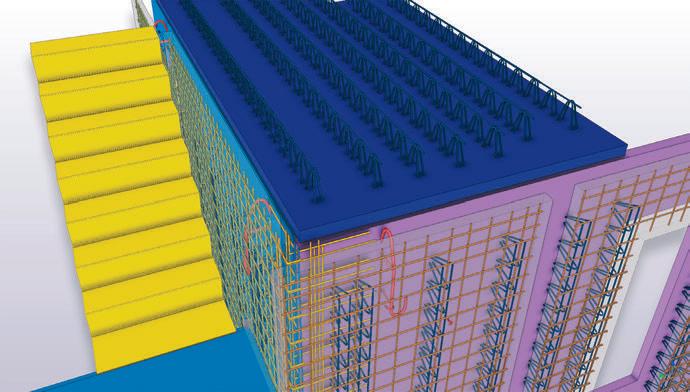
9

7 Tekla Structures now supports point clouds natively, which is useful for renovation projects 8 Continuing its focus on pre-cast concrete, the new release features an interactive tool for double walls 9 The new property pane makes it easier and quicker to handle and modify object properties
